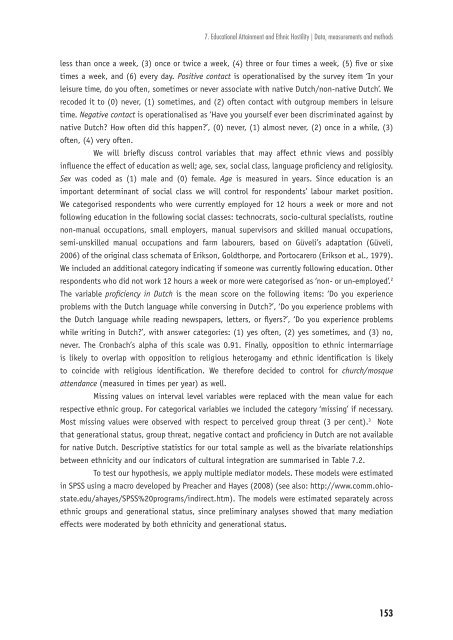Ethnic Hostility among Ethnic Majority and Minority Groups
Ethnic Hostility among Ethnic Majority and Minority Groups
Ethnic Hostility among Ethnic Majority and Minority Groups
You also want an ePaper? Increase the reach of your titles
YUMPU automatically turns print PDFs into web optimized ePapers that Google loves.
7. Educational Attainment <strong>and</strong> <strong>Ethnic</strong> <strong>Hostility</strong> | Data, measurements <strong>and</strong> methods<br />
less than once a week, (3) once or twice a week, (4) three or four times a week, (5) fi ve or sixe<br />
times a week, <strong>and</strong> (6) every day. Positive contact is operationalised by the survey item ‘In your<br />
leisure time, do you often, sometimes or never associate with native Dutch/non-native Dutch’. We<br />
recoded it to (0) never, (1) sometimes, <strong>and</strong> (2) often contact with outgroup members in leisure<br />
time. Negative contact is operationalised as ‘Have you yourself ever been discriminated against by<br />
native Dutch? How often did this happen?’, (0) never, (1) almost never, (2) once in a while, (3)<br />
often, (4) very often.<br />
We will briefl y discuss control variables that may affect ethnic views <strong>and</strong> possibly<br />
infl uence the effect of education as well; age, sex, social class, language profi ciency <strong>and</strong> religiosity.<br />
Sex was coded as (1) male <strong>and</strong> (0) female. Age is measured in years. Since education is an<br />
important determinant of social class we will control for respondents’ labour market position.<br />
We categorised respondents who were currently employed for 12 hours a week or more <strong>and</strong> not<br />
following education in the following social classes: technocrats, socio-cultural specialists, routine<br />
non-manual occupations, small employers, manual supervisors <strong>and</strong> skilled manual occupations,<br />
semi-unskilled manual occupations <strong>and</strong> farm labourers, based on Güveli’s adaptation (Güveli,<br />
2006) of the original class schemata of Erikson, Goldthorpe, <strong>and</strong> Portocarero (Erikson et al., 1979).<br />
We included an additional category indicating if someone was currently following education. Other<br />
respondents who did not work 12 hours a week or more were categorised as ‘non- or un-employed’. 2<br />
The variable profi ciency in Dutch is the mean score on the following items: ‘Do you experience<br />
problems with the Dutch language while conversing in Dutch?’, ‘Do you experience problems with<br />
the Dutch language while reading newspapers, letters, or fl yers?’, ‘Do you experience problems<br />
while writing in Dutch?’, with answer categories: (1) yes often, (2) yes sometimes, <strong>and</strong> (3) no,<br />
never. The Cronbach’s alpha of this scale was 0.91. Finally, opposition to ethnic intermarriage<br />
is likely to overlap with opposition to religious heterogamy <strong>and</strong> ethnic identifi cation is likely<br />
to coincide with religious identifi cation. We therefore decided to control for church/mosque<br />
attendance (measured in times per year) as well.<br />
Missing values on interval level variables were replaced with the mean value for each<br />
respective ethnic group. For categorical variables we included the category ‘missing’ if necessary.<br />
Most missing values were observed with respect to perceived group threat (3 per cent). 3 Note<br />
that generational status, group threat, negative contact <strong>and</strong> profi ciency in Dutch are not available<br />
for native Dutch. Descriptive statistics for our total sample as well as the bivariate relationships<br />
between ethnicity <strong>and</strong> our indicators of cultural integration are summarised in Table 7.2.<br />
To test our hypothesis, we apply multiple mediator models. These models were estimated<br />
in SPSS using a macro developed by Preacher <strong>and</strong> Hayes (2008) (see also: http://www.comm.ohiostate.edu/ahayes/SPSS%20programs/indirect.htm).<br />
The models were estimated separately across<br />
ethnic groups <strong>and</strong> generational status, since preliminary analyses showed that many mediation<br />
effects were moderated by both ethnicity <strong>and</strong> generational status.<br />
153












